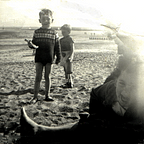Shortest Beatles Song?
Tracks got longer and shorter in the final years
Hands will shoot up in the courtroom demanding precise terms of reference. When does a snippet/interlude/songette get promoted to the big league? Both The Beatles/White Album and Let it Be have contenders in the twilight zone. The acoustic introduction to Revolution 9, for example, or the guitar interlude before Buffalo Bill.
Some might also clamour for the break-up releases — but that leads to the bottomless pit provided by Anthology. I am staying with the studio albums, ending with the Let it Be released in May 1971, though this may lead to an appeal on a technicality (see below).
Clockwork
Broadly, speaking the early singles and albums stuck to a strict radio-friendly formula: three minutes max, two minutes min. Paul McCartney seemed to have an internal musical alarm clock set for exactly 2:52.
As avid listeners, The Beatles instinctively understood radio formats. The one song that went over three minutes was Ticket to Ride’ (1965). Its additional ten seconds provided a talking point for DJs without compromising the schedule (a fast fade out avoided ‘crashing the pips’).
When The Beatles finally ‘went long’ with the just under four minutes of All You Need Is Love (1967) they did so as a statement: the first satellite broadcast needed something grand and mould breaking. This was taken a step further with Hey Jude (August 1968) which crashed the seven minute barrier with a fade still playing somewhere near you.
On albums — much less commercially important at this stage — they still stayed within the conventions until Sergeant Pepper. Two Lennon tracks on Revolver stretch right up to the three minute limit: Tomorrow Never Knows and I’m Only Sleeping but again it was the showpiece track: A Day in the Life that became stretched out to an unheard of 5.35.
On The Beatles they basically went bonkers, starting the 70s early with forever-jams. The longest of these: an inhuman 28 minute Helter Skelter was quietly shunted into the sidings by an increasingly perplexed George Martin
With characteristic flair, The Beatles went to both ends of the length continuum in their final work. Along with the very long tracks were contrastingly short ones: most obviously in the medley but also Honey Pie, Why Don’t We Do It In the Road, Goodnight, Maggie Mae etc.
At only 23 seconds, Her Majesty is the shortest Beatles song. It was unlisted on its original vinyl release, bursting into life 14 seconds after what appears to be the end of Side 2 of Abbey Road. This makes it one the first ‘Easter Eggs’ or hidden tracks, though this had not been the intention.
Recording
Ian Macdonald describes Her Majesty as a ‘party piece’ that McCartney was unsure how to use. It had been around at least November, 1968, when Paul had played a version during a Radio Luxembourg interview.
The Abbey Road recording sessions resumed after an eight week break on July 2nd, 1969. Arriving early at the studio Paul recorded three acoustic takes without the others. He then asked the engineers to experiment with inserting the fragment into the Long Medley.
In accordance with these instructions, Her Majesty was placed between Mean Mr Mustard and Polythene Pam. When this was played back at the end of the month Paul didn’t like the result.
‘Throw it away,’ he told engineer, John Kurlander. ‘It doesn’t work.’
Thankfully, all Abbey Road engineers had been instructed to never discard anything recorded by The Beatles. So Kurlander added the discarded song to the end of the master tape: inserting fourteen seconds of the lead-out tape which creates silence between “The End” and “Her Majesty”.
The next day Paul was listening to the playback — with the tacked-on Her Majesty ‘Now that works!’ he declared.
Beatles Penny Black?
The late inclusion of Her Majesty came too late for the designers to change the label or cover — a laborious process in the pre-digital era. This meant that the first (limited) pressing of the album did not include it.
New ‘corrected’ pressings were quickly issued but this process was complicated by the fact that there were multiple regional variations. Three uncorrected vinyl sleeves were released in the US, around fifty worldwide. Some of these are highly sought after by collectors.
Her Majesty now has a track listing and officially ends Abbey Road. Paul McCartney later declared it a ‘typical Beatles accident’ and a ‘fitting end to The Beatles recording career.
